Trees Birds Mammals Fish Amphibians Reptiles
Wild Algarve
Bookshop
Butyriboletus fechtneri (Velen.) Arora & J.L. Frank - Pale Bolete
Phylum: Basidiomycota - Class: Agaricomycetes - Order: Boletales - Family: Boletaceae
Distribution - Taxonomic History - Etymology - Identification - Culinary Notes - Reference Sources
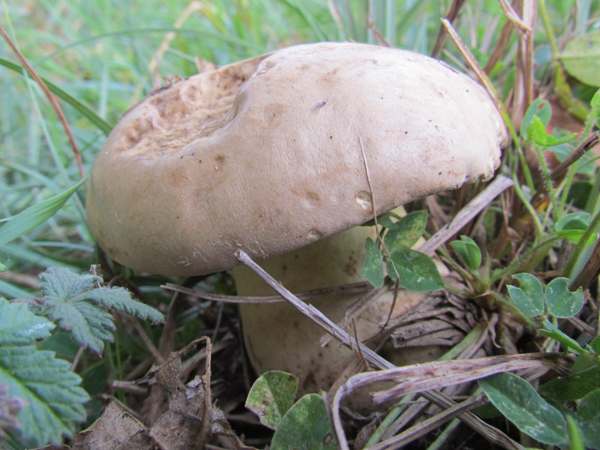
Wherever the Devil's Bolete, Rubroboletus satanas, occurs there is a always reasonable chance of also finding Butyriboletus fechtneri, which is rather more common than its infamous satanic relative. Viewed from above these two bolete species are reasonably similar, both in size and in appearance, but their stems are very different.
Distribution
Rare in Britain and Ireland, Butyriboletus fechtneri is more often seen in some mainland European countries particularly in central and southern Europe. The specimens shown on this page were photographed in the Dordogne region of France.
Taxonomic history
This bolete was priginally named and described by the famous Czech botanist and mycologist Josef Velenovsky (1858-1949), who gave it the scientific name Boletus fechtneri. In 2014, Americans David Arora and Jonathan L. Frank transferred the Pale Bolete to the new genus Butyriboletus, based largely on the results of molecular (DNA) analysis which has prompted a major revision of the family Boletaceae.
Common synonyms of Butyriboletus fechtneri include Boletus fechtneri Velen., Boletus appendiculatus ssp. pallescens Konrad, Bull., and Boletus pallescens (Konrad) Singer.
Etymology
The generic name Boletus comes from the Greek bolos, meaning 'lump of clay', while the Butyri- prefix to the new genus means 'buttery'. The specific epithet fechtneri honours the Czech mycologist František Fechtner (1883 - 1967).
Identification guide
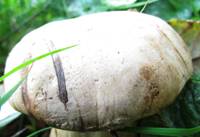 |
Cap
Ranging from 8 to 20cm in diameter, the cap of Butyriboletus fechtneri is
greyish to silvery white and velvety at first, darkening and sometimes having an olivaceous or slightly pinkish
tinge towards the margin. Young fruitbodies have rounded and domed caps, but with age they often develop slightly irregularly.
When cut, the yellow flesh of Butyriboletus fechtneri turns blue, most strongly in the region of the cap. |
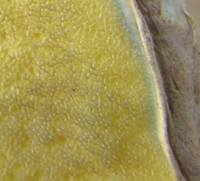 |
Tubes and Pores
The tubes of the Pale Bolete Boletus fechtneri are very small and initially lemon yellow, becoming deeper yellow before eventually developing an olivaceous tinge. When exposed to the air the tubes turn blue, as also do the tiny yellow pores if they are bruised.
|
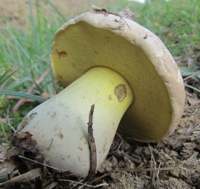 |
Stem
The stipe of Butyriboletus fechtneri is usually clavate (club shaped, as seen on the left) or occasionally cylindrical, sometimes tapering rapidly towards the base. (In my experience most specimens of Boletus fechtneri develop clavate, somewhat rooting stems when they are fully mature.)
Pale lemon yellow over its lower two thirds or so, the stem surface is more deeply yellow near the apex. Occasionally there is a pink or red-brown central zone, covered with very faint fine reticule (network). As with the rest of this bolete, the stem surface turns blue when bruised. Inside the stem the flesh is yellowish white, becoming more of a pinkish brown towards the base. |
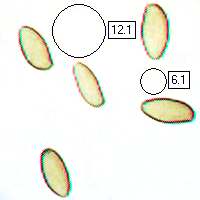 |
Spores
Subfusiform, 9-15 x 4--6µm.
Spore print
Olivaceous brown. |
Odour/taste |
Young specimens have a mild taste and no distinctive odour. |
Habitat & Ecological role |
This attractive bolete is found on chalky soil beneath beech, oak and sweet chestnut trees. Very occasionally it appears also under conifers, and then nearly always spruce. |
Season |
Late summer and autumn. |
Occurrence |
Rare in Britain and Ireland, Butyriboletus fechtneri is more often seen in certain mainland European countries particularly in central and southern Europe. The specimens shown on this page were photographed in the Dordogne region of France. |
Similar species |
Butyriboletus satanas has a chalky white cap, red pores and a bulbous red stem.
Caloboletus calopus has a pale cap and yellow pores; its stem is yellow towards the apex and red towards the base. |
Culinary Notes
Butyriboletus fechtneri is generally considered edible, but because of its rarity this mushroom should not be picked for the pot.
Reference Sources
Fascinated by Fungi, 2nd Edition, Pat O'Reilly 2016, reprinted by Coch-y-bonddu Books in 2022.
British Boletes, with keys to species, Geoffrey Kibby (self published) 3rd Edition 2012.
Roy Watling & Hills, A.E. 2005. Boletes and their allies (revised and enlarged edition), – in: Henderson, D.M., Orton, P.D. & Watling, R. [eds]. British Fungus Flora. Agarics and boleti. Vol. 1. Royal Botanic Garden, Edinburgh.
BMS List of English Names for Fungi
Dictionary of the Fungi; Paul M. Kirk, Paul F. Cannon, David W. Minter and J. A. Stalpers; CABI, 2008
Taxonomic history and synonym information on these pages is drawn from many sources but in particular from the British Mycological Society's GB Checklist of Fungi.
Top of page...
Fascinated by Fungi. Back by popular demand, Pat O'Reilly's best-selling 450-page hardback book is available now. The latest second edition was republished with a sparkling new cover design in September 2022 by Coch-y-Bonddu Books. Full details and copies are available from the publisher's online bookshop...